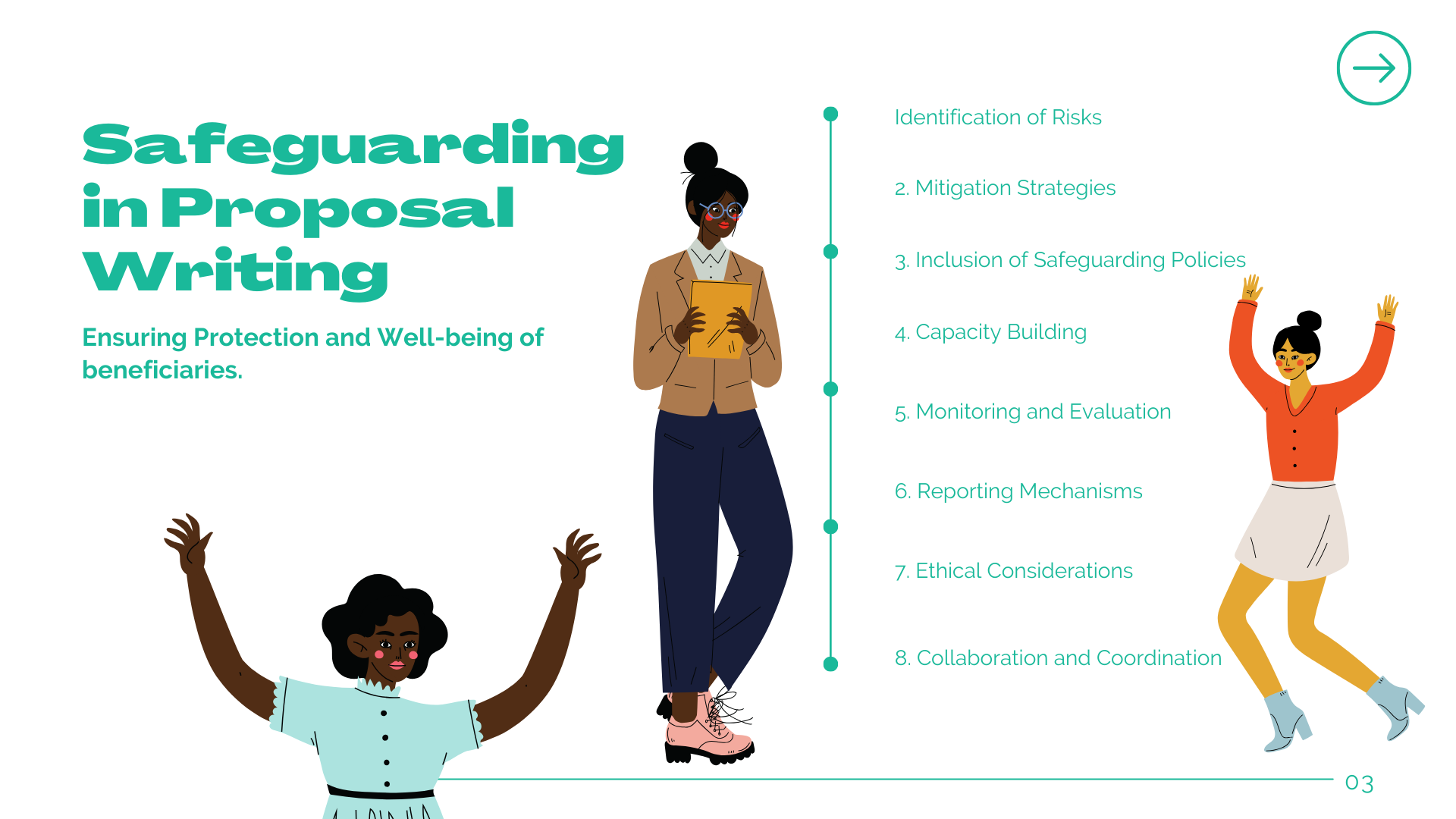Budget Donors use different forms of budget preparation, although they are similar in the key components, but we have to use the same donor’s form when preparing the pr

Safeguarding in Proposal Writing: Ensuring Protection and Well-being of beneficiaries.
Safeguarding in proposal writing is a critical aspect of project development, particularly in initiatives that involve working with vulnerable populations or addressing sensitive issues. It encompasses a range of measures aimed at protecting individuals, communities, and environments from harm or exploitation and ensuring their well-being throughout the project lifecycle. In this comprehensive guide, we will explore the key components of safeguarding in proposal writing, including the identification of risks, mitigation strategies, safeguarding policies, capacity building, monitoring and evaluation, reporting mechanisms, ethical considerations, and collaboration and coordination efforts.
1. Identification of Risks
The foundation of effective safeguarding in proposal writing lies in the identification of risks associated with the proposed project or program. This entails conducting a thorough risk assessment to understand the potential vulnerabilities of the target population and the context in which the project will be implemented. Risks may vary depending on factors such as gender, age, disability, ethnicity, socio-economic status, and cultural norms. It is essential to consider both internal and external risks, including those related to project activities, stakeholders, and the broader socio-political environment.
2. Mitigation Strategies
Once risks have been identified, the next step is to develop robust mitigation strategies to address them proactively. Mitigation strategies should be tailored to the specific context of the project and the needs of the target population. They may include the implementation of safeguarding policies, procedures, and guidelines to prevent harm or misconduct. For example, measures such as recruitment and vetting procedures for staff and volunteers, codes of conduct, and clear reporting mechanisms can help mitigate risks related to abuse, exploitation, and harassment.
3. Inclusion of Safeguarding Policies
Incorporating safeguarding policies into the proposal demonstrates a commitment to ethical conduct and the protection of vulnerable populations. These policies should outline the organization's approach to safeguarding, including its zero-tolerance stance towards abuse, exploitation, and other forms of misconduct. It is essential to provide clear guidance on expected behaviors, reporting procedures, and consequences for violations. Additionally, proposals should highlight adherence to international standards and guidelines for safeguarding, such as those set forth by the Inter-Agency Standing Committee (IASC) or relevant regulatory bodies.
4. Capacity Building
Building the capacity of project staff, partners, and stakeholders is essential for effective safeguarding implementation. Capacity building activities may include training on recognizing and responding to safeguarding concerns, promoting a culture of accountability, and establishing mechanisms for reporting and addressing safeguarding incidents. Training should be tailored to the specific roles and responsibilities of participants and conducted in a manner that is accessible, participatory, and culturally sensitive. Ongoing support and supervision are also critical to reinforce learning and ensure that safeguarding principles are consistently applied throughout the project.
5. Monitoring and Evaluation
Monitoring and evaluation play a crucial role in assessing the effectiveness of safeguarding measures and identifying areas for improvement. This may involve establishing indicators to measure the implementation of safeguarding policies, conducting regular audits or reviews, and soliciting feedback from beneficiaries and other stakeholders. Monitoring and evaluation efforts should be integrated into the broader project monitoring and evaluation framework to ensure alignment with project objectives and outcomes. Findings should be used to inform decision-making, adapt strategies as needed, and promote continuous learning and improvement.
6. Reporting Mechanisms
Establishing accessible and confidential reporting mechanisms is essential for creating a safe environment where individuals feel comfortable reporting safeguarding concerns. Reporting mechanisms should be clearly communicated to all project stakeholders and include multiple channels for reporting, such as hotlines, email, or in-person consultations. It is crucial to ensure that reporting mechanisms are culturally sensitive and respect the autonomy and confidentiality of individuals who come forward with concerns. Reports should be promptly investigated, and appropriate actions taken to address safeguarding incidents in line with organizational policies and procedures.
7. Ethical Considerations
Ethical considerations are central to safeguarding in proposal writing and should underpin all project activities and decision-making processes. This includes upholding principles of dignity, respect, non-discrimination, and consent in all interactions with project beneficiaries and stakeholders. It is essential to recognize and respect the rights and autonomy of individuals, especially those from marginalized or vulnerable groups. Ethical considerations should be integrated into project design, implementation, monitoring, and evaluation to ensure that the project promotes the well-being and empowerment of all individuals involved.
8. Collaboration and Coordination
Collaboration and coordination efforts with relevant stakeholders are critical for strengthening safeguarding measures and promoting accountability at all levels. This may involve engaging with government agencies, civil society organizations, local communities, and other key actors to share best practices, coordinate responses to safeguarding concerns, and advocate for policy changes. Collaborative partnerships can enhance the effectiveness and sustainability of safeguarding efforts by leveraging resources, expertise, and networks to address complex challenges and systemic issues.
In conclusion, safeguarding in proposal writing is essential for ensuring the protection and well-being of individuals, communities, and environments affected by proposed projects or programs. By integrating safeguarding principles and practices into project design, organizations can demonstrate their commitment to ethical conduct, accountability, and the promotion of human rights. Through a combination of risk identification, mitigation strategies, policy inclusion, capacity building, monitoring and evaluation, reporting mechanisms, ethical considerations, and collaboration and coordination efforts, organizations can effectively safeguard against harm and promote the dignity, safety, and empowerment of all individuals involved.
Subscribe to Newsletter
Subscribe, We'll send you the latest grants and blogs for free
